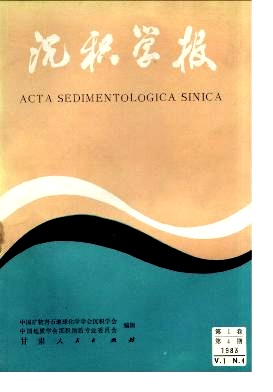Han Dexin, Ren Deyi, Guo Mintai. ORIGIN OF BARK LIPTOBIOLITE AND ITS DEPOSITIONAL ENVIRONMENT OF CHANGGUANG COALFIELD,ZHEJIANG PROVINCE[J]. Acta Sedimentologica Sinica, 1983, 1(4): 1-16.
| Citation:
|
Han Dexin, Ren Deyi, Guo Mintai. ORIGIN OF BARK LIPTOBIOLITE AND ITS DEPOSITIONAL ENVIRONMENT OF CHANGGUANG COALFIELD,ZHEJIANG PROVINCE[J]. Acta Sedimentologica Sinica, 1983, 1(4): 1-16.
|
ORIGIN OF BARK LIPTOBIOLITE AND ITS DEPOSITIONAL ENVIRONMENT OF CHANGGUANG COALFIELD,ZHEJIANG PROVINCE
- Received Date: 1983-03-16
- Publish Date:
1983-12-10
-
Abstract
Changguang coalfield is located in northwestern Zhejiang.The coal-bearing formations of the Late Permian are widely distributed in the lower Yangtze region and have long been known as the Longtan formation with depositional features and great amount of bark in coal seams.This paper deals mainly with the origin of bark liptobiolite and its depositional environment.As a result of the Permian tectonic movement,many large and small basins came into existence in South China where were deposited sandstone,siltstone,shale,thin一bedded limestone and coal seams.Most of the valuable coalfields were formed during this time.The coal-bearing formation in Changguang basin contains chiefly four coal groupsA.B,C and D,in which C coal seam is rather thick,its thickness may reach 1.3-2 m and especially its western part can be mined. C coal seam is usually interspersed with some lenses of skeletal limestone or shell limestone.Both these limestones consist of abundant marine fossils such as brachiopods, pelecypods,crinoids,etc.It is evident that these beds of skeletal limestone bearing marine fossils represent temporary inundatien of coastal swamp by the sea.Based on the sedimentary analysis,a set of sediments including C coal seam show the depositional features of the marine swamps lowlands.C coal seam is mainly dull bituminous coal whose structure is rather simple.It contains a large percentage of suberinite (average 67%)sometimes up to 80-95%,which indicates that there is a close relationship between the depositional environment and the Permian coal-forming plant communities.It is more important to note that the bark coals originate from the selective decomposition of plant materials,that other materials such as lignin,cellulose,protein and their diagenesis products are wholely decomposed and drifted by flowing water and that resistant materials become concentrated under a reducing condition.Hence the bark coal may also be called bark liptobiolite.The bark liptobiolite in this region can be grouped into two types:the first one which develops from plants after decomposition, forms coal in situ, and the second one is hypautochthonovs coal, which develops from plant remains transported not far fiom their original sites.These two types of coal occur more often in this coal basin than in other regions.Under the microscope, in reflected light is dark grey and usually shows orange-yellowish subcrinite fluorescence.Location:Niutoushan No.1 Vitrinite Romax0.77%,Suberinite Romax0.27%,Niu-toushan No. 6. Vitrinite Romax1.06%,Suberinite Romax0.67%,typical bark coal (suberinite above 80 %):Vr155.86%,Hr1 7.11%,SgQ 3.85%,Ag1 12.19%.Besides, pyrite and clay minerals are usually scattered in seams and these bituminous coals influenced by the sea are characterized by the presence of high sulphur (3.8-6.6%)The results suggest that these coal seams are formed in coastal marine swampy lowlands and the depositional environment is suitable for concentration of plant fragments.Obviously,the formation of bark coals may be affected generally by the following factors:depositional environment,the type of deposition and the coal-forming plant communities.
-
References
|
[1]
|
1.谢家宋,1933,江酉乐平煤一中国煤之一新种,中国地质学会志,第12卷弟1期。
2.阎俊峰、李广有,1958,乐平附近煤田地质及乐平煤,地质学报,第38卷第3期。
3.任德贻等,1963,江西萍乐凹陷乐平组含煤建造煤岩煤质特征,中国地质学会第32届学术年会论文选集(地层、煤田地质)。
4.杨起、韩德馨,1979,中国煤田地质学(上册),煤炭工业出版社,
5.朱绍隆、朱德寿,1979,浙北龙潭组主采煤层(C)特征及树皮煤的成因,1979年全国第一届煤田会议交流文件。
6.骆善胜,1980,长广煤田C煤层海相成煤的初步认识,煤炭学报,1980,第3期.
7.西安煤田地质勘探研究所,浙江长广煤田新杭矿区龙潭组抱粉组合,煤田地质与勘探,1976,第2期
8.E .Stach et al.,1975,Stach's Textbook of Coal Petrology
9.W.Spackman,D.W.Scholl,W.H.Taft,1964 ,Environments of Coal Formation
10.E .C .Dapples.M.E.Hopkins.1969,Environments of Coal Deposition,Boulder
11.M .L .Shirley et al.,1966,Deltas in Their Geologic Framework,Houston Geological Society,
12.R .A .Davis.Jr.(ed.),1918, Coastal Sedimentary Environmenls,New York Heidelberg,Berlin,Springer-Verlag
13.J.M .Erankenherg and D.A.Eggerr,1969,Petrified Stigmaria from North America: Part I,Stigmaria ficoides,the Underground Portions of Lepidodendraceac,Palaeontographica, Abt. B, Band 128, Lfg. 1-2, 1-47
D .H .Scott, 1962,Studies in Fossil Botany,3rd edition,Hafner Publishing Company,New York
14.H.X.Andrews, 1961,Studies in Palaeobotany,New York,
15.B.A.Thomas,1978,Carboniferous Lepidodendraceae and Lepidocarpaceae.The Botanical Review,Vol.44,No.3,321-364
16.A. D.Cohen,W.Spackman,1980,Phytogenic Organic Sediments and Sedimen-tary Environments in the Everglades-Mangrove Complete of Florida, Part III.,The Alteration of Plant Material in Peats and the Origin of Coal Macerals,Palaeontographica, Abt. B,Band 172, Lfg. 5-6, P.125-149, Stuttgart
17.A.D.Cohen, W. Spackman,1977,Phytogenic Organic Sediments and Sedimen-tary Environments in the Everglades-Mangrove Complel of Florida,Part II.,The Origin,Description and Classification of the Peats of Southrrn Florida,Palaeontog-raphica, Abt.B, Band 162, Lfg.4-6, P, 71-114, Stuttgart |
-
-
Proportional views

-






 DownLoad:
DownLoad: